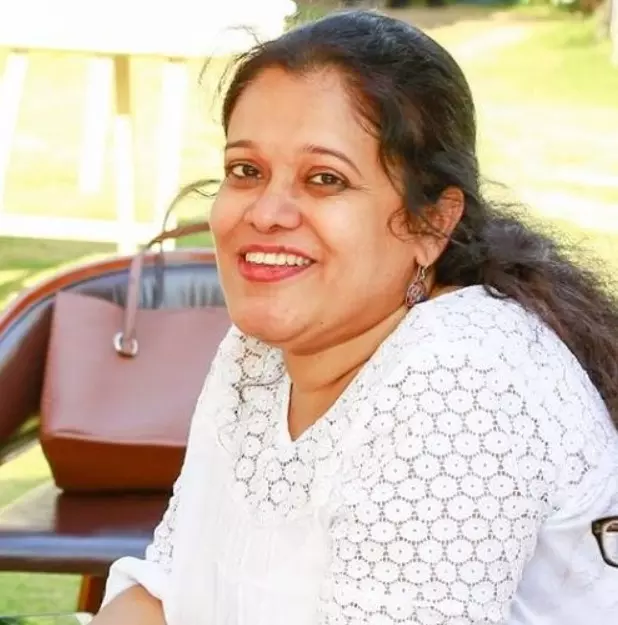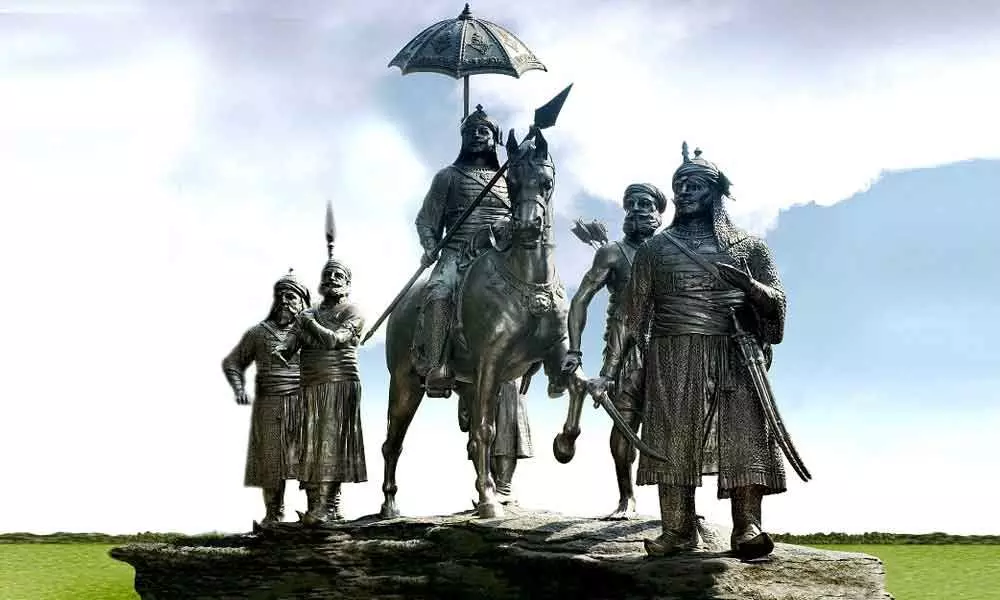Live
- WPL 2025: Matthews, Sciver-Brunt and Harmanpreet carry MI to massive 213/4
- MLA Anirudh Reddy Accuses KTR of Involvement in Manhattan Project Scam
- TGPSC Clarifies on False Propaganda Regarding Group-1 Recruitment
- Hyderabad Police Ensures Security as Holi and Ramadan's Second Friday Coincide
- Five MLCs Elected Unopposed in Telangana Under MLA Quota
- Sambhal prepares for a peaceful Holi with tightened security and special patrols
- CNG, PNG prices to become cheaper in Rajasthan from March 14
- Anti-Rape ad to screen in theaters before movies, like health advisories
- Prodigy Finance Offers Three Scholarship Awards totalling an amount of $19,000 for Global Students Starting Fall 2025
- Champions League drama likely to affect La Liga with big games this weekend
I-Day homage to Rana Pratap & his league of extraordinary men: India's first freedom-fighters


Tableau of Rana Pratap and his warrior-leaders at the Parliament House, New Delhi, unveiled on August 21, 2007. Sculptor-artist: Faqir Charan Parida. Photo courtesy: MMCF/The City Palace, Udaipur
Tributes on Independence Day to Maharana Pratap of Mewar on his 480th year of his birth and the leadership he inspired in the 16th century CE
Four hundred and eighty years after his birth in the fort-city of Kumbhalgarh in 1540 CE, Maharana Pratap continues to be hailed as one of India's greatest heroes. Much-respected and revered throughout the country, the life and achievements of Maharana Pratap have been compared to Lord Rama, the Prince of Ayodhya; even more often the Maharana is acknowledged as India's first freedom-fighter.
As the nation celebrates the foundation of the Ram Mandir at Ayodhya on August 5th and the Independence Day on August 15th, Dr Rima Hooja's recent book (titled Maharana Pratap – The Invincible Warrior, published by Juggernaut) recalls key attributes which make the Maharana a unique figure in the annals of India's civilizational history.
"Mewar was a well-established kingdom," she writes about the 16th century CE, "much eulogised for its tradition of valour in battle, and tracing its physical entity in the region to nearly one thousand years before Pratap's birth. The origin myth of the Sisodias, Mewar's ruling clan, categorized them as descendants of the Sun – Suryavanshi – thus descendants of King Rama, warrior-god-hero of the Indian epic, the Ramayana."
On the theme of independence, Dr Hooja writes, "Mewar enjoyed a special status among the Rajputana kingdoms, not because of its thousand-year history but also because of the valour with which it defended its independence." The independence was from the suzerainty of the Mughal Empire which Maharana Pratap and his forefathers had refused to acknowledge.
In the 21st century, every Indian, every school student is aware of the Battle of Haldighati; the historic battle between the Rajput warriors and the Mughal army is till date recounted by bards, folk poets, theatre artists, historians and playwrights. Needless to say, the battle remains an epic melodramatic chapter in the history of Mewar.
Chroniclers like Col James Tod waxed eloquent on the popularity and image of Rana Pratap writing his Annals and Antiquities of Rajasthan in 1820s: "The brilliant acts he achieved during the period live in every valley; they are enshrined in the heart of every true Rajput, and many are recorded in the annals of conquerors. To recount them all, or relate the leadership he sustained, would be to pen what they would pronounce a romance who had not traversed the country where tradition is yet eloquent with his exploits, or conversed with the descendants of his chiefs, who cherish a recollection of the deeds of their forefathers, and melt, as they recite them, into many tears."
Today what is gaining greater recognition are the values and belief systems of the 16th century CE which form the context to best understand personalities like Rana Pratap and the generations whom he inspired.
Breathing new life: "Rana Pratap emerges in an age when the entire Kshatriya identity or asmita was lost, drowned as it were in a sea of convenience-seeking," said Pandit Shri Narendra Mishra, one of India's greatest living 'veer-ras' poets. "When there was shameless slavery to dependence, Pratap rises as a synonym of self-respect and self-pride. He was instrumental in breathing new life into the concepts of self-respect and independence," said Panditji, whose poetry captures the spirit of those times.
Rana Pratap was never alone. He was a man of the people, who as a young adult, spent formative years working and allying with Bhil tribals and Meenas in the Mewar region. There are fables and songs referring to Rana Kika, as he was endearingly addressed by them. Here was a son of the soil devoting years to motivating and mobilising people around him: tribals, peasants, soldiers, landed gentry and mercantile classes alike. No wonder the Bhil leader Rana Punja remained a close aide of Rana Pratap, spearheading guerilla campaigns and leading a contingent of tribal warriors onto the battlefield of Haldighati.
"The ease with which he dealt with people, his simplicity and ethical leadership made him popular with different segments of society," wrote Dr Devilal Paliwal in a 1998-Hindi monograph simply titled, Maharana Pratap Mahan. "Added to these qualities were his prowess on the battlefield, his bravery and determination to fill his people with new hopes and renew their self-confidence," he said.
If a leader is known by the extraordinary talent he attracts, Rana Pratap's core team comprised a spectrum of men whose achievements have withstood the test of time. Bhamashah is one towering personality hailing from a Jain Oswal family which had served the Ranas of Mewar for generations. He is not only the Diwan of Chittorgarh but becomes the chief financier for Rana Pratap's battles against the Mughal Empire and even takes to the battlefield! His loyalty to the Rana is matched by his multidimensional management skills.
As a tribute to Bhamashah's memory, the government of Rajasthan launched the Bhamashah Yojana in 2008, a direct benefit transfer scheme for women's empowerment; while the Maharana of Mewar Charitable Foundation, Udaipur instituted Bhamashah annual awards for meritorious students of Rajasthan.
The Charans earned their immortality, both Rama Sandhu and Mala Sandhu. Their soulful poetry recounted glories and traumas on and off the battlefields. Sadhu Hemratan Suri is another poet-warrior whose ballads on 'Gora Badal' are still heard across the Aravallis.
Chakrapani Misra, a Sanskrit scholar and man of science, wrote Vishwa Vallabha a landmark treatise on agriculture. His knowledge on water resources would have been instrumental in the founding of Udaipur in 1559 along the banks of the man-made lake Pichola.
A case study titled 'India's Mewar Dynasty: Upholding 76 Generations of Service and Custodianship', conducted through 2008-10 by Prof John L Ward and Prof K Ramachandran of Kellogg School of Management and Indian School of Business, Hyderabad, noted: "The battle (of Haldighati) was typical of those Mewar fought over its long history: a defensive one. Mewar maintained a powerful military force, but it was not a mercenary army...most soldiers acted as volunteers who believed in their king's leadership and were ready to lay down their lives for the sovereignty of their State."
Kellogg-ISB study quoted the present head of Mewar family, Shriji Arvind Singh Mewar, "Mewar's army fought on the issue of principle, not for an empty stomach for which the Rana had to pay. The majority of the people who worked in the army and fought with the enemies did not have any salaried income from the army. Mewar had no money to afford a professional army."
To these values of self-reliance, self-respect, respect for mankind which the age of Rana Pratap and his men exemplified, Pandit Mishra's poetry paints colours of powerful emotions: "If independence is a mantra for the land of Bharat, then Rana Pratap is its singer or gayak / In the fight for Freedom, he remains unconquered, continuing to rule over Time." He is the 'kaal vidhayak'.
Poetics of the age, the original ideas of those times lose their significance and power as the duel over words and epithets like 'great and greatest' continues in today's India. Geography too keeps changing its contours. Haldighati is revered, Gogunda and Chavand are relegated to backwaters of public memory. A capital-city of Rana Pratap, Chavand was once a bustling cultural centre.
New imaginations were at play; new realities were being constructed. Iconic personalities of the 16th century CE are metaphors of an age that can neither be allowed to fade away nor be naively remembered for singular achievements. Those were extraordinary times and leaders like Maharana Pratap will remain iconic role-models for the leadership they inspired in the men around them.
Dr Hooja recounts the final days of Maharana Pratap when "he called upon some of his closest nobles and advisers to pledge to keep up the struggle against the Mughal forces…His eldest son and heir apparent, took a pledge that he would live up to the task given to him: namely, to administer with justice and honour the kingdom of Mewar; and to never allow Mewar to become a part of the Mughal Empire."
"Even during his lifetime," she concludes, "Maharana Pratap had become a legendary figure, hero-worshipped for his courage and determination against tremendous odds, in maintaining Mewar's independence, and upholding Rajput honour. Over the centuries, the legend only grew and he remains today an enduring symbol of patriotism, valour and chivalry."
There could not be a better time to pay our homage to these great souls.
Contribution by: Raju Mansukhani
Pandit Narendra Mishra addressing the audience at Manek Chowk on the occasion of the Maharana Mewar Foundation Awards ceremony on March 1st, 2020. Photo courtesy: MMCF/The City Palace, Udaipur
At the Pratap Kaksh in The City Palace Museum the arms, armoury, paintings and bust of Rana Pratap are displayed for the thousands who throng every day to pay their homage. Photo courtesy: MMCF/The City Palace, Udaipur

© 2025 Hyderabad Media House Limited/The Hans India. All rights reserved. Powered by hocalwire.com






